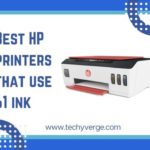Are you curious about the difference between Sublimation Printing and Silkscreen? Look no further! In this article, we will delve into the fascinating world of these two printing techniques commonly used to adorn fabric and non-fabric materials like ceramics.
As the printing industry continues to evolve and expand, numerous products with advanced technical features have emerged to cater to various printing needs.
In this comprehensive guide, we will explore the intricacies of both Sublimation Printing and Silkscreen.
We will discuss their unique advantages, limitations, and functions, allowing you to gain a deeper understanding of these remarkable printing techniques. So, without further ado, let’s embark on this enlightening journey!
What is Sublimation Printing?
Sublimation is a special digital printing technique that involves the use of inkjet printers. In this process, the sublimation ink and the fabric are heated at a high temperature through the heat press.
This allows the fabric to expand, and the ink is sublimated on its surface in gaseous form. As a result, a permanent impression of designs is left on the fabric materials.
What is Silk Screen?
The silkscreen is an analogous printing technique that involves the use of Stencil. The ink is placed on this stencil and a squeegee is used to push it down through the screen.
As the ink passes through the screen, a binder is used to permanently attach it to the surface of the fabric. It is generally a very old but effective printing method.
Difference between Sublimation printing & Silkscreen:
As you have the basic definitions of both these printing methods. As a result, you can say that they have a huge difference concerning each other, we will compare them so, you can easily differentiate between them.
1. Printing Techniques
In printing manners, the sublimation method is completely different from the silkscreen. As it involves direct conversion of your sublimation inks from their solid to gas form.
First, the sublimation printers produce a design. This design is then shifted onto the transfer papers as the mirror image. In the end, it is transferred to the materials through the heat press at high pressure and temperature.
On the other hand, the silkscreen involves a prepared silkscreen mesh. On which ink is dropped. Beneath this screen is the main fabric material. This ink is pushed through this screen onto the fabric.
In the end, a heat dryer is used to fix the designs or the images on the fabric materials. The process is simple and does not require much time.
2. Implementation
Sublimation printing methods are used to sublimate many kinds of materials. In addition, for this purpose, the materials should have some polyester coatings on their surfaces.
These polyester coatings allow the sublimation ink to permanently bind itself to the surface of your materials. This process is used to sublimate ceramics, fabrics, metals, and even plastic materials.
While Silkscreen printing is a universal printing method. Therefore, people are using it for ages. It has glue and protective coverings. It can easily sublimate all fabric and non-fabric hard or soft materials.
3. Advantages & Limitations
Sublimation printing is best for short-run printing orders. As it can produce high-quality, versatile, and multiple-color images as its main output. It can also be controlled by various software programs. Its only limitation is the lower range of substrate sublimation.
In opposition, the Silkscreen printing method is perfect for long-run orders. Moreover, this method is guaranteed to produce highly versatile and vibrant images. In comparison to sublimation printing, its only limitation is its lower image quality.
Frequently Asked Questions
The main difference between Sublimation Printing and Silkscreen lies in the printing process. Sublimation Printing uses heat to transfer ink onto the surface, while Silkscreen involves pushing ink through a mesh screen onto the material.
Both Sublimation Printing and Silkscreen are suitable for printing on fabric materials. However, Sublimation Printing is often favored for its ability to produce vibrant, long-lasting prints with excellent color accuracy.
Yes, Silkscreen can be used on non-fabric materials like ceramics, glass, and metal. Its versatility allows for printing on a wide range of substrates.
Sublimation Printing offers several advantages, including the ability to achieve intricate details, smooth gradients, and vibrant colors. It also allows for printing on polyester fabrics and provides excellent durability.
Silkscreen is well-suited for simple and bold designs. While it can handle some degree of complexity, it may not be the best choice for highly intricate or detailed designs.
The cost-effectiveness of Sublimation Printing vs Silkscreen depends on various factors such as the volume of prints, complexity of designs, and materials used. Generally, for short-run print jobs, Sublimation Printing may be more cost-effective, whereas Silkscreen can be more economical for long-run print jobs.
Conclusion
In conclusion, when it comes to choosing between Sublimation Printing and Silkscreen, it’s essential to consider your specific requirements. Silkscreen is the ideal choice for long-run print jobs that call for simple designs and a wide range of substrates.
On the other hand, if you’re seeking short-run print jobs that demand high quality, intricate details, and flawlessly smooth prints, dye sublimation is your best bet.
By exploring the differences between Sublimation Printing and Silkscreen, we hope this article has expanded your knowledge about these remarkable printing techniques.
Armed with this newfound understanding, you can now make more informed decisions when it comes to selecting the most suitable printing method for your projects. So go ahead, experiment, and let your creativity shine through!
- Can You Sublimate on Nylon and Polyester? Which oneis the Best - February 19, 2024
- Converted Epson Eco Tank Et-2800 Vs Et-2803 Sublimation Printer [Review 2024] - February 19, 2024
- Can You Reuse Sublimation Prints? (The Righ Answer) - February 19, 2024





![Top 100+ FAQs Related to Sublimation Printing & Heat Press [Updated 2024] faqs related to sublimation Printing](https://www.techyverge.com/wp-content/uploads/2022/08/faqs-related-to-sublimation-Printing--150x150.jpg)
